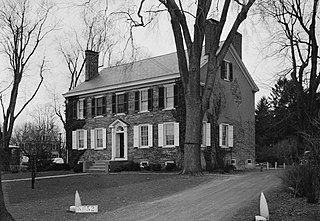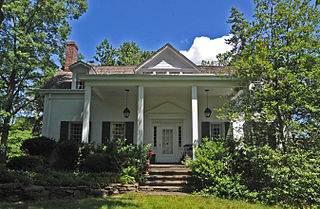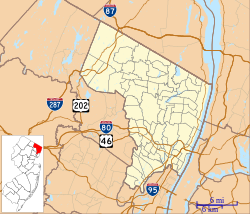
The Steuben House is a noted example of Bergen Dutch sandstone architecture, located at New Bridge Landing on the Hackensack River in River Edge, in Bergen County, New Jersey, United States.

The Lawrence Township Historic District is a 550-acre (220 ha) historic district encompassing the community of Lawrenceville in Lawrence Township, Mercer County, New Jersey, United States. It was added to the National Register of Historic Places on September 14, 1972 for its significance in architecture, landscape architecture, literature, military history, and transportation. The district includes 45 contributing buildings.

The Grover Cleveland Birthplace is a historic site located at 207 Bloomfield Avenue in Caldwell, Essex County, New Jersey, United States. It is the only house museum dedicated to U.S. President Grover Cleveland.

Mays Landing Presbyterian Church is a historic church built in 1841 and located at Main Street and Cape May Avenue in the Mays Landing section of Hamilton Township in Atlantic County, New Jersey, United States. It was documented by the Historic American Buildings Survey (HABS) in 1938 and was added to the National Register of Historic Places on April 20, 1982, for its significance in architecture and religion. The church was added as a contributing property to the Mays Landing Historic District in 1990.

New North Reformed Low Dutch Church is a historic Reformed church on East Saddle River Road at Old Stone Church Road in Upper Saddle River, Bergen County, New Jersey, United States. The church was built in 1819 and added to the National Register of Historic Places on April 15, 1982.

Moravian Church is a historic church building located on Swedesboro-Sharptown Road in the Oliphant's Mill section of Woolwich Township, Gloucester County, New Jersey. The church was dedicated in 1789 and documented by the Historic American Buildings Survey (HABS) in 1938. It was added to the National Register of Historic Places on April 3, 1973, for its significance in architecture and religion. The property is currently under the stewardship of the Gloucester County Historical Society.

St. Thomas Episcopal Church is a historic church located at the southeast corner of Main and Focer streets in the borough of Glassboro in Gloucester County, New Jersey. It was built in 1846 and documented by the Historic American Buildings Survey (HABS) in 1937, with an addendum in 1984. It added to the National Register of Historic Places on March 3, 1975, for its significance in architecture.

St. Luke's Episcopal Church is a historic Episcopal church building located at 346 High Street in the Hope section of Hope Township in Warren County, New Jersey, United States. Built from 1832 to 1839, it was documented by the Historic American Buildings Survey (HABS) in 1937. The stone church was added to the National Register of Historic Places on March 16, 2007, for its significance in architecture and religion. It had been previously added as a contributing property to the Hope Historic District on July 20, 1973.

The Eckerson House is a historic stone house located at 280 Chestnut Ridge Road in the borough of Montvale in Bergen County, New Jersey, United States. The oldest section of the house dates to 1796, with an addition in 1799, and a second story in 1890. It was documented as the Abram G. Eckerson House by the Historic American Buildings Survey (HABS) in 1937. The house was added to the National Register of Historic Places on January 10, 1983, for its significance in architecture. It was listed as part of the Early Stone Houses of Bergen County Multiple Property Submission (MPS).

The Thomas Maskel House is located on Bacon's Neck Road near the Greenwich section of Greenwich Township in Cumberland County, New Jersey, United States. The building was documented by the Historic American Buildings Survey (HABS) in 1939. It was added to the National Register of Historic Places on June 10, 1975, for its significance in exploration/settlement.

Dickinson House is located on Brickyard Road in Alloway Township of Salem County, New Jersey, United States. The house was built in 1754 and was documented by the Historic American Buildings Survey (HABS) in 1939. The house was added to the National Register of Historic Places on February 20, 1975, for its significance in architecture.

The Martin Berry House is located in Pompton Plains in Pequannock Township, Morris County, New Jersey, United States. The house was built in 1720 and documented by the Historic American Buildings Survey (HABS) in 1939. It was added to the National Register of Historic Places on June 19, 1973, for its significance in architecture and settlement. Built by the son of one of the first settlers to the Pompton River region, the pre-Revolutionary War building has been little altered since its construction.

The Lambertville Historic District is a 198-acre (80 ha) historic district encompassing the community centered around the intersection of Route 29 and Route 179 in the city of Lambertville in Hunterdon County, New Jersey, United States. The district was added to the National Register of Historic Places on June 30, 1983, for its significance in architecture, commerce, industry, and settlement. It includes 680 contributing buildings, and two contributing structures.

The Millstone Historic District is a historic district located in Millstone, Somerset County, New Jersey. The district was added to the National Register of Historic Places on September 13, 1976 for its significance in education, military history, settlement, and transportation. It includes 58 contributing buildings.

The Oldwick Historic District is a 170-acre (69 ha) national historic district located along County Route 517, Church, King, James, Joliet and William streets in the Oldwick section of Tewksbury Township in Hunterdon County, New Jersey. The district was added to the National Register of Historic Places on November 14, 1988, for its significance in architecture, commerce, and industry. It includes 127 contributing buildings, 12 contributing structures, and one contributing site. The Kline Farmhouse, listed individually in 1984, also contributes to the district. Many of the buildings were documented by the Historic American Buildings Survey.

The Middlesex Avenue–Woodwild Park Historic District is a 89-acre (36 ha) historic district located in the borough of Metuchen in Middlesex County, New Jersey, United States. The district was added to the National Register of Historic Places on July 31, 2017, for its significance in architecture, social history, community planning and development. It includes 201 contributing buildings, five contributing objects, and one contributing site. The Borough Improvement League House, also known as the Old Franklin Schoolhouse, was documented by the Historic American Buildings Survey (HABS) in 1936, and St. Luke's Episcopal Church in 1960.

The Asbury Historic District is a 288-acre (117 ha) historic district encompassing the community of Asbury in Franklin Township of Warren County, New Jersey. It is bounded by County Route 632, County Route 643, Maple Avenue, Kitchen Road, and School Street and extends along the Musconetcong River into Bethlehem Township of Hunterdon County. It was listed on the National Register of Historic Places on March 19, 1993 for its significance in architecture, industry, religion, community development, politics/government, and commerce. The district includes 141 contributing buildings, a contributing structure, two contributing sites, and four contributing objects.

The Raven Rock Historic District is a 53-acre (21 ha) historic district located along Daniel Bray Highway and Quarry Road in the hamlet of Raven Rock in Delaware Township in Hunterdon County, New Jersey, United States. It was added to the National Register of Historic Places on November 10, 2015, for its significance in architecture and community development. The district includes 15 contributing buildings, 2 contributing sites and 13 contributing structures.

The James Townley House is a historic farmhouse on the campus of Kean University located at the intersection of Morris Avenue and Green Lane in Union Township, Union County, New Jersey. It was documented by the Historic American Buildings Survey (HABS) in 1939. The house was added to the National Register of Historic Places on May 14, 1979, for its significance in architecture.

The Timothy Mills House is a historic house built c. 1740 and located at 27 Mills Street in the town of Morristown in Morris County, New Jersey. It was documented by the Historic American Buildings Survey in 1939. It was added to the National Register of Historic Places on February 24, 1975, for its significance in architecture.




























